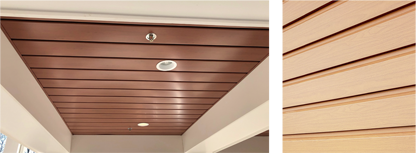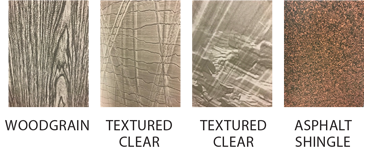Coil-coated prints are the buzzworthy shortcuts of sophisticated metal product design. From delicate veining to enchanting shimmer, this coating technique takes color and effects to new heights and depths.
We live in a colorful world filled with pattern, texture, sheen, and shimmer; with architecture and design at the forefront of social media, television, and magazines, visual inspiration is everywhere. Innovations in coil coatings have made it possible to attain almost any aesthetic on prepainted metal. Woodgrain? No problem. Brick? It’s been done. Marble? Yep, it’s viable too! Thanks to the process of coil-coated printing, all of these designs are possible.

The Look
Coil-coated printing involves layered inking to create a distinctive pattern or design, such as stone, patina, brushed metal — the list goes on. Commonly used for wall panels, roofing, and garage doors, coil-coated prints are most famously known for their building and architectural applications, but they’re also used for appliances and specialty applications like entry doors, pool liners, and metal storage shacks. As a popular alternative to substrates such as wood, stone, and natural metals, they can achieve a combination of desired aesthetics and exceptional durability.


Let’s dive into some of the most popular looks:

- Wood: Woodgrain finishes have seen increasing demand for some time, and you will find them on any number of building components and office products, such as wall panels, soffit panels, entry doors, file cabinets, and more.
- Rusted Metal: What if a barn was made out of high-performance metal roofing and siding products printed to appear rusty and old but actually weren’t? Get the charm of a weathered finish on your installation; available from a number of manufacturers.
- Custom Patterns: Brushed metal, accent stripes, and other “wallpaper” patterns are available if you’re looking for a unique print. These can be custom-engineered to fit the exceptional profiles of the many custom metal cladding products serving the architectural community.

The coatings (or “ink”) used to produce the patterns are engineered for weathering and longevity, enabling coil-coated prints to maintain their visual appeal and structural integrity for years. Additionally, prepainted metal, depending on the substrate and gauge, can be lightweight, easy to handle, and can be roll-formed into a variety of shapes and sizes, which makes it an ideal construction material in situations where stone or brick may not be suitable. These are a few of the reasons why product manufacturers and specifiers may prefer the use of metal products over real wood or stone.
Another reason is cost, as metal can often be a more affordable option than other substrates.

The Process
The first steps of the coating process involve applying a base coat followed by subsequent ink coats that stamp or engrave the chosen design. There are two primary methods of coil-coated print application: rotogravure and flexographic. Rotogravure (or gravure for short) printing uses a rotary printing press, applying ink directly to the coil using a metal plate and printing cylinder that rotates in an ink pan. Flexographic printing uses an engraved elastomer image carrier to transfer ink from a printing plate onto a substrate. Both methods use various combinations of a base coat, ink(s), and top or clear coats. While these techniques are engineered to achieve coil-coated prints, choosing the right application method largely depends on the individual project, substrate, end use, weatherability, and a variety of other factors.
The process of developing a specific pattern or design for coil-coated prints varies. In some cases, product manufacturers design the pattern or scheme internally and then work with a stamping or rolling company to create the actual printed roller for the inking process. In other instances, manufacturers can be inspired by coil coating suppliers or product manufacturers who often work directly with the coater to create their own designs.

On the Rise
The benefits of prepainted metal span from environmental advantages to economic efficiencies, making it the substrate of choice for numerous applications and products. While manufacturers seek its performance, durability, and affordability; architects, engineers, and consumers — the parties who create the demand for prepainted products — find its aesthetic benefits to be undeniable.
As demand for coil-coated prints rises, we can expect the arrival of more exciting and unique print technologies to provide aesthetic solutions for all markets. With endless color and print combinations available, there are seemingly limitless creative solutions for any project.
For applications where a solid color just won’t do, consider using a coil-coated print. To learn more about coil-coated prints, contact your coil coater or coil coatings supplier.



